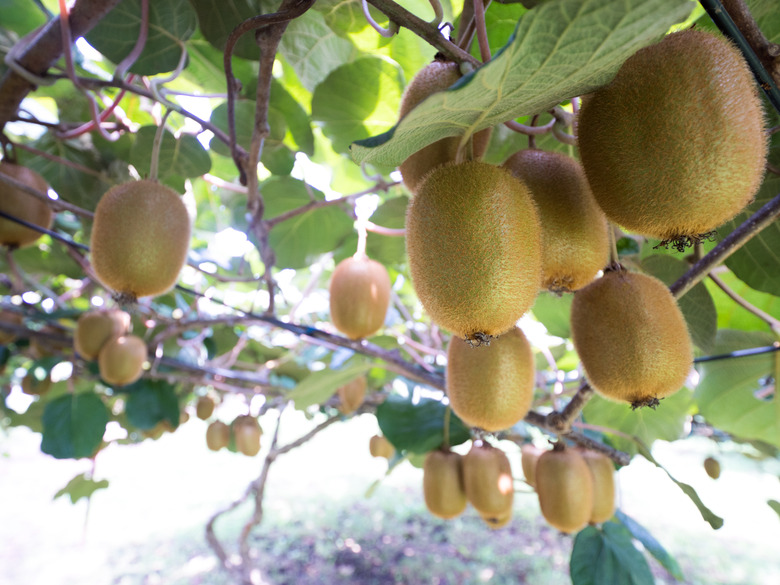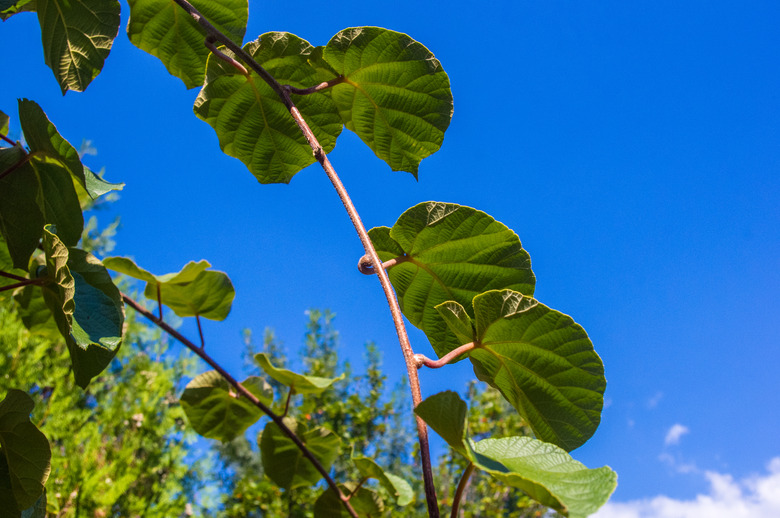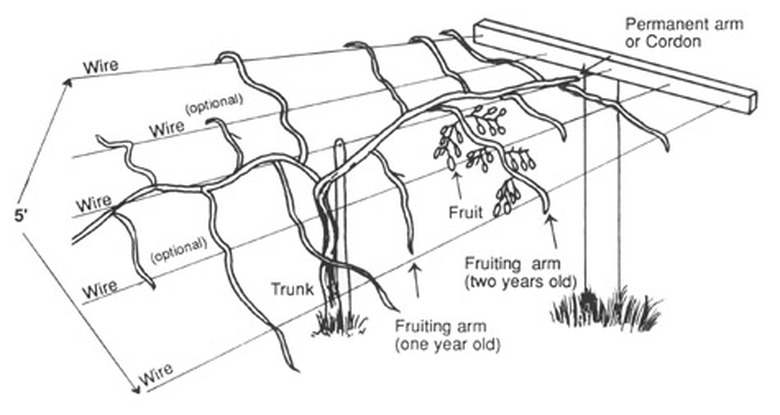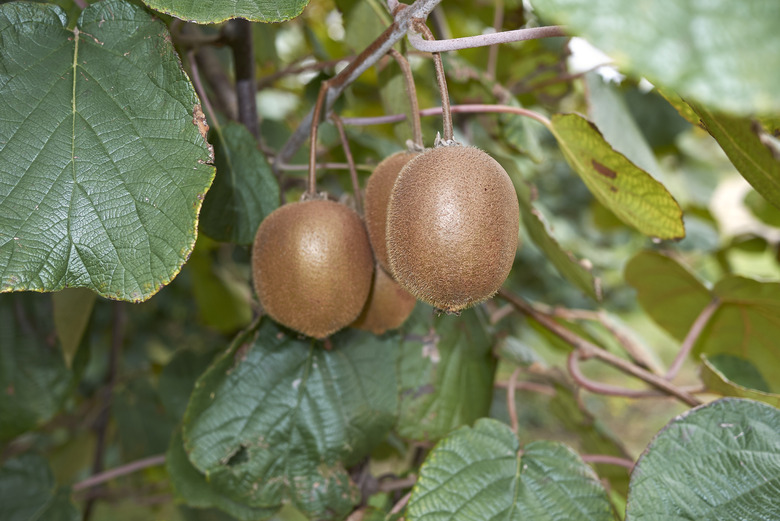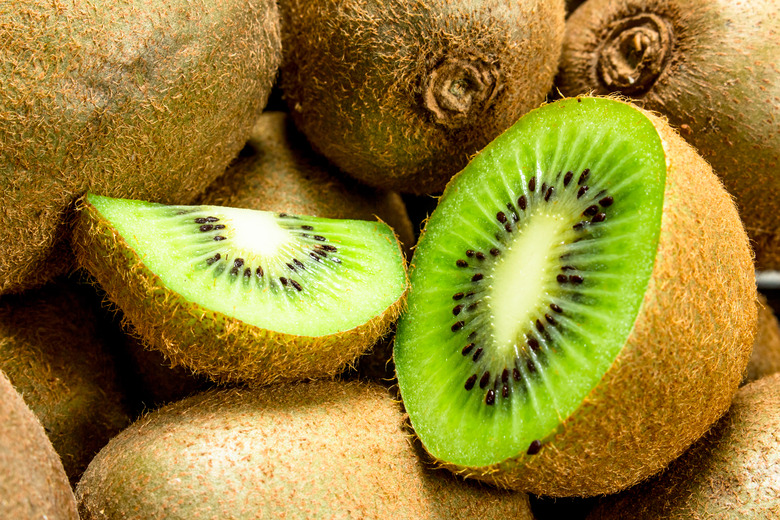How To Grow Kiwi
The familiar fuzzy kiwi fruit you get at the grocery store comes from a woody vine that can be grown in USDA plant hardiness zones 8 and 9. Its scientific name is Actinidia deliciosa and it is native to China, although today it is grown throughout the world. Kiwi gets its common name from its resemblance to the kiwi bird of New Zealand, the location where the fruit was first widely grown for commercial production. Growing Actinidia deliciosa in your home garden is not difficult but requires careful training and pruning to ensure robust vines and plentiful fruit. Kiwi vines are hardy in USDA zones 8 and 9.
Grow Kiwi in Pairs
Grow Kiwi in Pairs
Actinidia deliciosa is a dioecious plant, meaning it requires both a male and a female plant to produce fruit. The male pollinates the female, and only the female plant bears fruit. So if you want fruit from your kiwi plant, you have to grow more than one. The vines can grow very large—often 20 to 30 feet long—so most home gardeners plant just two. But if you want to plant more, you can have up to eight females for every male.
Soil, Sun and Water for Growing Kiwi
Soil, Sun and Water for Growing Kiwi
Kiwi vines like moist soil, but it must be well-drained. Standing water will quickly rot the vine. The optimal soil pH is 5.5 to 6.0—slightly acidic. Plant the vines in full sun—preferably where they will be protected from strong winds anytime of year; they are susceptible to wind damage. They will tolerate some light shade.
Water the soil to keep it moist, especially while establishing the plant. Do not keep the soil wet or let water pool at the base of the trunk. It's best to use drip irrigation to ensure the plants receive regular watering but not too much.
Planting Kiwi Vines
Planting Kiwi Vines
Dig a hole a little larger than the roots but not deeper. The roots should fit without bending. Set the plant in the hole and backfill with the removed soil. Do not add fertilizer, as kiwi roots are susceptible to burning. The top of the soil should just cover the roots and should not extend up the trunk or main shoots. If you're planting more than one female plant, space them about 15 feet apart. Males can be closer to females but must be within 50 feet to ensure pollination.
Fertilizer for Kiwi Vines
Fertilizer for Kiwi Vines
Feed your kiwi plants with regular doses of nitrogen, such as with urea or ammonium nitrate, increasing the amount as the plants mature. In the first year, apply 0.4 ounces of nitrogen per month in May, June and July (application times may vary by climate). In the second year, feed them 0.8 ounces of nitrogen each month in April through July. In years three and four, apply 2 to 3 ounces of nitrogen each month in March through July. Mature vines may need up to 1 pound of nitrogen per year; the majority of this is applied in March (during bud break), and the rest is applied in May or June.
Supporting Kiwi Plants
Supporting Kiwi Plants
Unlike some woody vines, kiwi should not be grown as trees. The plants do not have strong trunks and, when grown as trees, can be damaged by the weight of heavy fruiting. It's better to grow your kiwi with a T-bar trellis or other support, such as an arbor.
A T-bar trellis looks much like an old-fashioned clothesline, with two T-shaped supports spaced about 20 feet apart and five parallel, horizontal wires strung between the supports. At the center between the T-bars, another vertical support, such as a wire or pole, guides the trunk of the vine up to the wires. Once the trunk reaches the wires, you encourage two shoots to grow horizontally along the center wire, in opposite directions. These are called cordons. From each cordon, additional, smaller shoots grow across the wires (perpendicular to the wires); these are the fruit-bearing canes.
When grown commercially, the wires typically are about 6 feet above the soil, but yours can be somewhat higher or lower, depending on the structure. It's also possible to grow kiwi espalier-style, creating multiple pairs of horizontal cordons.
After planting, train your kiwi to climb the vertical upright of the trellis or other support, using loosely tied cloth, cord or tape. Do not let the vine wind around the support. If there is more than one vigorous shoot in the new plant, select the best one to become the trunk, and cut back the others. Prune suckers on the trunk to reserve energy for the main shoot.
Training and Pruning Kiwi Vines
Training and Pruning Kiwi Vines
Developing kiwi for healthy fruit production starts with a three-year process of training and pruning, followed by regular pruning thereafter. In the first year, the main goal is to train the trunk up the vertical support, ideally until it reaches above the cross support. At the end of this growing season, head back the trunk to 2 inches below the cross support.
In the second year, train two shoots from the trunk to grow in opposite directions along the center wire (or other horizontal support); these are the cordons. Prune off all suckers and additional shoots to promote growth of the cordons. Tie the cordons to the center wire every 18 inches. It's possible that your vines will develop cordons in the first year.
Allow fruiting canes to extend from the cordons at 8- to 12-inch intervals, and train these over the neighboring wires, forming a canopy along the trellis. Cut back all other shoots and suckers. At the end of the second season, prune the cordons and canes back to where they are 1/4 inch in diameter.
In the third year, fruit will grow from the pruned canes; it always grows from the previous year's shoots. Depending on the plant and your climate, it may be beneficial to limit the amount of fruit in the early years, until the canopy of foliage is more full and can protect the fruit from the sun. It also may be necessary to prune in winter to ensure adequate light exposure for the next year's blooms.
Harvesting Kiwi Fruit
Harvesting Kiwi Fruit
Kiwi fruit can be harvested as early as late-September and as late as mid-November, depending on the climate and growing conditions. The fruits typically are full size by the end of August but are not ready for harvesting until their sugar content increases into fall. You can leave mature fruits on the vine until they are soft, but you have to eat them right away. Otherwise, you can pick them early and store them in the refrigerator (above 32 degrees F) for up to four months, then let them ripen at room temperature. The best way to know that kiwi are ready to harvest is to cut one open: they're ready when the seeds inside are black.
